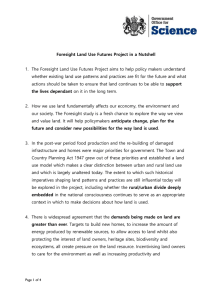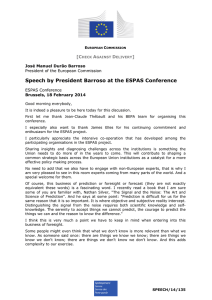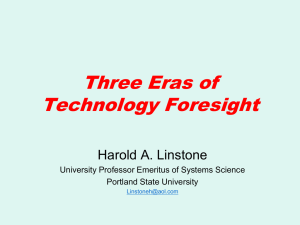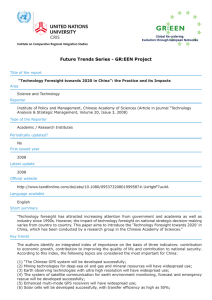Strategic foresight
advertisement
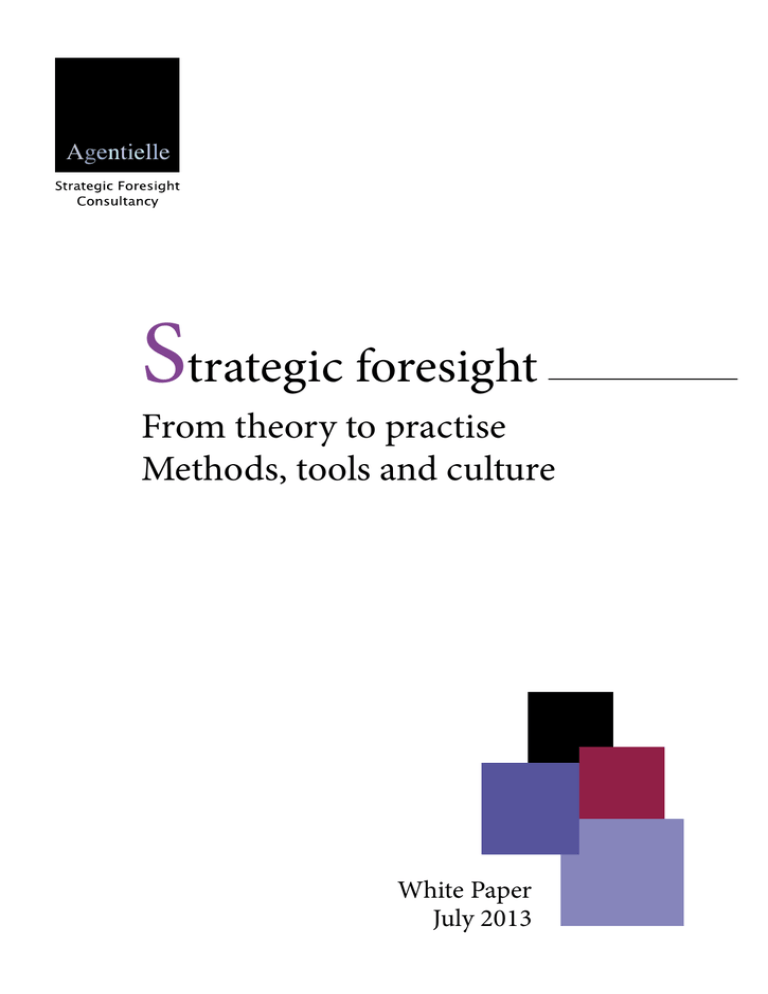
Strategic foresight From theory to practise Methods, tools and culture White Paper July 2013 I. What is strategic foresight ? 1. Definition . . . . . . . . . . . . . . . . . . . . . . . . . . . . . . page 4 2. Strategic foresight : a business culture. . . . . . . . . . . . . . . . . . page 6 II. Different types of strategic foresight 1. The 3 main elements . . . . . . . . . . . . . . . . . . . . . . . . . page 7 2. Main strategic foresight activities . . . . . . . . . . . . . . . . . . . . page 8 III. Reasons for implementing a strategic foresight system 1. Efficiently grow your business . . . . . . . . . . . . . . . . . . . . . 2. More specifically, satisfy your information needs . . . . . . . . . . . . . 3. Effective information management . . . . . . . . . . . . . . . . . . . 4. Practical cases • Derlante & Associates . . . . . . . . . . . . . . . . . . . . . . . . . • Baumann Decker . . . . . . . . . . . . . . . . . . . . . . . . . . . page 9 page 10 page 11 page 13 page 14 IV. How to implement a strategic foresight system ? 1. Step 1: Define needs and goals . . . . . . . . . . . . . . . . . . . . . 2. Step 2: Determine the oversight scope . . . . . . . . . . . . . . . . . . 3. Information management . . . . . . . . . . . . . . . . . . . . . . . 4. Overview of strategic foresight tools and solutions. . . . . . . . . . . . . 5. The different steps . . . . . . . . . . . . . . . . . . . . . . . . . . page 15 page 16 page 17 page 18 page 19 V. Key factors of success 1. Setting realistic goals and expectations . . . . . . . . . . . . . . . . . page 20 2. Careful implementation . . . . . . . . . . . . . . . . . . . . . . . . page 21 3. The information specialists . . . . . . . . . . . . . . . . . . . . . . page 22 To conclude . . . . . . . . . . . . . . . . . . . . . . . . . . . page 23 © Strategic Foresight White Paper - July 2013 - www.agentielle.com 2 Strategic foresight is now widely used in organizations, businesses, and administrations. It is an integral part of global strategies and corporate cultures. It is used by a wide range of professionals: intelligence experts, consulting firms, marketing, sales and strategy departments. Strategic foresight is a tool, which provides a better understanding of the future and can be used to detect upcoming risks, opportunities and trends. It successfully helps deal with uncertainty. However the term, as well as the practices, may seem too vague and conceptual. So what does strategic foresight exactly mean? What are its features, methods, and benefits? Who are the foresight professionals and the end users? An overview of the definitions, techniques and case studies related to strategic foresight is necessary to shed light on this ambiguous term. The purpose of this white paper is to show how strategic foresight can improve your company’s efficiency and provide an accurate view of your environment and its emerging opportunities and threats. © Strategic Foresight White Paper - July 2013 - www.agentielle.com 3 I. What is strategic foresight ? I.1 Definition • Richard A. Slaughter gives this definition : Strategic foresight is the ability to create and sustain a variety of high quality forward views and to apply the emerging insights in organizationally useful ways; for example, to detect adverse conditions, guide policy, shape strategy; to explore new markets, products and services. Slaughter defines it as a process that attempts to broaden the boundaries of perception in four ways : - By assessing the implications of present actions, decisions, etc. (Consequent assessment) - By detecting and avoiding problems before they occur (early warning and guidance) - By considering the present implications of possible future events (pro-active strategy formulation) - By envisioning aspects of desired futures (preparing scenarios) • Averil Horton defines the entire foresight process in the following way : It has three distinctive phases which are: ‘input’, ‘foresight’ and ‘output’. Each phase creates greater value than the previous one, as the outputs move up the information value chain from information through knowledge to understanding, and finally to wisdom. However, this value is only realized at the very end of the process and even then often with a significant time lag. Each phase is also more difficult and time consuming, more abstract, and less easy to measure than the preceding one. In a successful foresight process, these three phases will result in taking decisions and actions which will be different to those which would have been carried out in the absence of the process. © Strategic Foresight White Paper - July 2013 - www.agentielle.com 4 • Definition from the FOREN report : European Commission Research Directorate General: A Practical Guide to Regional Foresight (FOREN) Foresight is a systematic, participatory, future-intelligence-gathering and medium-tolong-term vision-building process aimed at present day decisions and mobilizing joint actions. Foresight arises from a convergence of trends underlying recent developments in the fields of ‘policy analysis’, ‘strategic planning’ and ‘future studies’. It brings together key agents of change and various sources of knowledge in order to develop strategic visions and anticipatory intelligence. The difference between Foresight and other planning activities relates to the participative dimension of foresight. Common features of foresight include: a long-term orientation, the examination of a wide range of factors, the drawing on widely-distributed knowledge, the institutionalization and creation of and the use of formal techniques/methods. Formal methods provide more operational results, assess the consistency of different aspects of the vision, help to identify where more knowledge is needed and legitimize the exercise. Foresight is a very evocative label for the rise to prominence of participative methods and long-term strategic futures techniques, in the wake of more traditional ways of informing policy planning. • Our definition Strategic foresight is a set of methods, tools, technologies and actions, which provide an accurate description of both the current and future business environment of an organisation. It is used to predict possible changes in the environment in order to minimize potential risks and capitalise on opportunities. Strategic foresight combines technology (mining tools) and expert analysis to determine the factors which will most likely have an impact on the business environment and the development of the organisation. It involves examination of the information, its analysis, its selection and its diffusion to end users. © Strategic Foresight White Paper - July 2013 - www.agentielle.com 5 I.2 Strategic foresight : a business culture Strategic foresight began within the Anglo Saxon (UK, US, Canada and Australia) context in the eighties. Regardless of whether the systems and practises differ from one organisation to another and from one country to another, the organisational goals are still the same: to improve the effectiveness of global strategy and to accelerate business growth. Regionally, some differences are notable: Anglo Saxon cultures: collaborate and share information within companies. They use a variety of information management tools and they share best practices across the organisation. France: autonomous and individual use of information within the same organisation. There is little interest in using collaborative knowledge management tools. Despite these dissimilarities, the needs and interest in strategic information are increasing in both regions. Foresight tools and systems, which identify and follow new events in the business context are equally appreciated. During this last decade, strategic foresight has progressively entered corporate culture. It is now adopted by a large number of corporations and, to a lesser extent, by medium and small-sized businesses. The budget required for a strategic foresight system may be the main reason most decision makers have not already implemented it, as they do not have the necessary material and human resources to proceed. However, as the benefits far outweigh the costs, this system should be seriously considered, particularly, when developing and implementing a global strategy. © Strategic Foresight White Paper - July 2013 - www.agentielle.com 6 II. Different types of strategic foresight II.1 The 3 main elements There are as many strategic foresight types as there are needs. Nevertheless, there are three areas, which are defined for each system : 1) The business environment The information requirements depend on the type of business, the sector it is in and the responsibilities of the person who needs the information: an engineer doesn’t require the same type of information as a marketer . Is legal, technical or economic information required ? What kind of industry news is needed ? • • 2) The strategic and sales focus Here the information needs depend on the strategic and sales goals. Which competitors should be followed ? What type of product/service innovations and trends should be studied ? • • 3) The monitoring and analysis scope • Should only the European competitors be followed or should the global ones followed as well ? • Is only information from official documents needed or are other informal types also useful? • Are there specific sources of information that should be considered ? © Strategic Foresight White Paper - July 2013 - www.agentielle.com 7 • II.2 Main strategic foresight activities • Strategic foresight on competitors : involves monitoring and analysing the competitive environment of a corporation : market, competitors, vendors, patents… • Strategic foresight on the business environment : involves watching the business sectors in which the corporation operates. • Strategic foresight on technology : involves studying and monitoring technologi- cal innovations and trends which are likely to have an influence on the corporation’s growth and direction. • Strategic foresight (general) : involves combining different strategic foresight activities, which are directly related to the corporation’s global strategy. • Strategic foresight on the sales activity : involves monitoring and analysis of the sales (such as, distribution channels) and market environment of products and services. • Strategic foresight on the legal environment : involves maintaining an oversight on any changes in legislation that may have an impact on the corporation’s business activities. • Strategic foresight on reputation : involves examining and following brand perception per target segment and the general public. Certainly, all the strategic foresight types mentioned above can be combined together within the same system. Besides these ones, other strategic foresight systems exist: health monitoring system, oversight of key social issues system… Some examples of strategic foresight scopes : STRATEGY SCOPE INDUSTRY SCOPE SALES SCOPE REPUTATION / BRAND SCOPE COMPETITIVITOR SCOPE © Strategic Foresight White Paper - July 2013 - www.agentielle.com LEGAL SCOPE TECHNOLOGY SCOPE 8 III. Reasons for implementing a strategic foresight system III.1 Efficiently grow your business Your business needs information to ensure its competitiveness and development. Relevant and timely information allows you to be proactive. With this knowledge you can evaluate your strengths and weaknesses, improve your market position amongst other things. Most of the time businesses don’t have the upper hand on information flows. A significant part of strategic information remains invisible. Thus many decision makers have to act within a significant degree of uncertainty. Implementing a strategic foresight system provides targeted information which helps decision makers improve their global strategy and drive business growth, as they have a more accurate view of the current and future business environment. With a strategic foresight system, you will be able to : • Understand your business environment: economic context, new regulations, changing prices… • Anticipate change: new trends, emerging opportunities, potential risks… • Take action : seize opportunities, minimize risks… • Develop and grow : improve your short and mid-term business strategy, strengthen the competitiveness of your business, better overall performance… UNDERSTAND YOUR BUSINESS ENVIRONMENT DEVELOP AND GROW The virtuous circle initiated by a strategic foresight system : © Strategic Foresight White Paper - July 2013 - www.agentielle.com ANTICIPATE CHANGE TAKE ACTION 9 III .2 More specifically, satisfy your information needs The strategic foresight system is implemented according to expressed information needs. From one day to another these needs may change. The information landscape is complex, overloaded, and fluctuating. Companies have to deal with this complexity to meet their urgent needs which vary within the same team, department, regional office, etc. If these needs are not fulfilled, even within a single business unit, there is a negative impact on the overall business performance. It is thus worthwhile to implement a strategic foresight system. Variety and complexity of information needs across the organisation : SALES DEPARTMENT ... MARKETING DEPARTMENT STRATEGIC FORESIGHT SYSTEM STRATEGY DEPARTMENT R&D DEPARTMENT © Strategic Foresight White Paper - July 2013 - www.agentielle.com 10 III.3 Effective information management Companies would like to have key, relevant and strategic information before their competitors. The increasing number of information forms and sources increases the difficulty of handling the process of information management: information collection, analysis and distribution. Adopting a strategic foresight approach to manage the information overload will have the following results: • A manageable flow of filtered and accurate information from reliable sources • Timely information allowing companies to be proactive • Information that meets end users’ needs Strategic foresight improves access to key information by setting up an effective information management system. © Strategic Foresight White Paper - July 2013 - www.agentielle.com 11 Some examples of diverse information sources : Web and forums TV and Radio Social Media Patent and Pratices, Rex Laws and regulation R&D documents INFORMATION SOURCES Professional associations Published theses and essays Journals and organizations Daily and specialized newspapers Conferences and seminars Private networks and clubs Databases © Strategic Foresight White Paper - July 2013 - www.agentielle.com 12 III.4 Practical cases • Example 1 : Derlante & Associates Derlante & Associates is a marketing and communication agency with a 100 employees. The company is based in Lyon, France. Consultants work independently; they each have their own information sources and documentation. There is no centralised management information system. About 2 years ago Derlante acquired a consultancy firm, Redheer. The firm had an information management team and system, but it was eliminated after the restructuring. The following year, Derlante lost an important call for tender from a national bank wanting to evaluate the position of its brand on the market. The team in charge of the bid had not included critical information in its proposal to the client. Soon after, the team met with the former Redheer information management team to discuss how to improve internal information management, which is key to the bidding process. The former employees told them about the strategic foresight solution and their experiences with it. The strategy department decided to hire two information system experts to manage and implement the system. Information needs are frequently re-evaluated and information is regularly diffused according to the needs of each department, such as to complete calls for tender, understand the economic situation, etc. The principal information users have noticed an increase in their effectiveness and considerable time savings, as they can now better anticipate the future business environment. One year after the implementation of the system, the agency had a number of new customers which resulted in an increase in sales revenue of 5.2% versus an average of 3.8% in previous years. © Strategic Foresight White Paper - July 2013 - www.agentielle.com 13 • Example 2 : Baumann Decker Baumann Decker is a famous chocolate maker. The company was created in 1885 and owns twenty shops. Raw material prices (particularly cacao and sugar) have a direct impact on the company’s profitability and competitiveness. Hence, a significant amount of resources are used to monitor and manage these prices. In 2010, the company’s Product Development manager attended a European conference on raw materials prices and their fluctuation. A speaker at the event introduced the strategic foresight system as an effective solution to deal with this issue. He presented the main benefits and functions of this system, which are the ability to monitor, anticipate and take action. Subsequently, the Development manager decided to implement a similar solution to monitor price changes in key cacao producing countries. A comparative study looking at the implementation of an internal system and an outsourced solution was completed. The latter was found to be the most cost-effective solution. Consequently, a specialized consultancy in information management was engaged for the implementation of the system, the follow-up and the diffusion of the information. The company was able to use the targeted information generated from the system to stabilize their purchase costs within two years of implementing the strategic foresight solution; their yearly purchase costs of cacao decreased by 18%. The solution also included an overview of chocolate consumer trends. The information that emerged showed a new demand for organic products. Consequently, Baumann Decker launched a new organic chocolate product range, which has been quite successful on the market. © Strategic Foresight White Paper - July 2013 - www.agentielle.com 14 IV. How to implement a strategic foresight system ? IV.1 Step 1: Define needs and goals The first step involves the identification and collection of information needs. This will define the targets; clearly defined goals will avoid any potential ambiguity and provide more relevant information results. The following questions will help set goals : • What are my business risks? • What are the reasons for implementing a strategic foresight system ? • Which benefits and results do I expect ? • What relationship will the system have with the other business units, departments ? • Who is the intended user of the information generated from the strategic foresight system ? The strategic foresight system has to be implemented in accordance with the company’s strategic needs and the end users’ needs and responsibilities. © Strategic Foresight White Paper - July 2013 - www.agentielle.com 15 IV.2 Step 2: Determine the oversight scope This step is quite strategic as the content and sources to follow are identified and delimited. This involves specifying the topics to track, such as the competitors and the geographical areas. The scope depends on the company’s sector of activity. For instance if a global company needs a strategic foresight solution, the following factors will be followed and analysed : • Company’s name, reputation and senior management • Its brands, product lines, technology, patents • Main competitors’ brand reputation, services, products, technology and patents • Changes in economic and legal context • Changes in the domestic and foreign markets • Professional unions and associations Once the scope has been defined, the combination of keywords must be set up. This “equation” will match the topics of interest. For instance : • Company name OR brand • Company name OR brand AND quality • Company name OR brand AND reliability The more the equation is concise the more relevant the results will be. © Strategic Foresight White Paper - July 2013 - www.agentielle.com 16 IV.3 Information management Information management involves the process of information: collection, analysis and diffusion. • Collection Due to digital information overload, manual information collection is not possible. Customized automated solutions and tools are needed to deal with the mass of data. They can be set up to follow a specific topic, capture the relevant information and diffuse it. • Analysis Despite the use of automated tools, human analysis still plays a significant role. Due in part to semantic ambiguity, a technical solution cannot replace analysis by a strategic foresight expert. Also, a specialist is required to implement and update these tools. • Diffusion Preferences for the format, diffusion frequency, information form (raw or selected) need to be clearly defined and depend on the end user. © Strategic Foresight White Paper - July 2013 - www.agentielle.com 17 IV.4 Overview of strategic foresight tools and solutions Information and data can be collected with free or commercial tools and solutions. Both types can be used in combination to cover a wider scope. However, when deciding on a solution, the budget and the implementation conditions must be kept in mind. Below are the main categories for the tools and solutions : • Global intelligence solutions combine different information management options such as monitoring, collection, analysis, and diffusion. Some of them may also offer other automated functionalities. • Collection tools (such as feed aggregators, web search engines and crawlers) gather information related to a previously selected list of keywords. • Analysis solutions offer semantic analysis and a range of other analysis functionalities such as text-mining and mind-mapping. • Information diffusion mediums which range from boards, curation platforms, social media to many others. • Knowledge capitalisation solutions are future-oriented and can be combined with a strategic foresight system. They capture and transform individual and organisational experience, strategic information and knowledge content into capital that can be used in the future by others. Some examples are newsletters, RSS feeds, the Intranet, social business networks, knowledge management platforms and bookmarking. © Strategic Foresight White Paper - July 2013 - www.agentielle.com 18 IV.5 The different steps DEFINE NEEDS AND GOALS - Context - Expectations DETERMINE OVERSIGHT SCOPE - Concepts and keywords - Sources and types of data MANAGE INFORMATION : COLLECTION - Automated tools and technologies MANAGE INFORMATION : ANALYSIS - Selection and validation process MANAGE INFORMATION : DIFFUSION © Strategic Foresight White Paper - July 2013 - www.agentielle.com - Frequency and format 19 V. Key factors of success V.1 Setting realistic goals and expectations The information specialists with the client need to agree upon attainable goals and deliverable results. Accordingly, the solution’s real value should be understood in addition to its return on investment (ROI). One can expect the following benefits from a strategic foresight solution for their company : • Time savings – less time spent searching and analyzing information • More efficiency – key targeted strategic information delivered in the format required so you can focus on completing your reports and presentations • Better and informed decision making – by having more clarity on present and future business contexts With regards to ROI, to have a clear idea of the profitability of the investment, it is essential to calculate a realistic budget and to monitor the total costs over the solution’s lifecycle (during the short, medium and long term). © Strategic Foresight White Paper - July 2013 - www.agentielle.com 20 V.2 Careful implementation The implementation of a strategic foresight system must follow a precise set of steps. Respecting each stage is a key factor of success. • Before the implementation At this initial step, clearly defined information needs is fundamental, as it has an impact on the system design. An overcomplicated or overspecialised system is as much of a risk as is a too simplistic strategic foresight system. It is one of the most common causes of failure. It can generate unexpected costs and frustration. The best system is one, which satisfies the end users’ information needs in terms of quality and quantity of information: Does the information meet their expectations? Is the volume of information delivered too high or not high enough ? • During the implementation Successful implementation requires that system experts actively collaborate with end users. A testing phase provides an additional guarantee that the solution fits their information needs, as necessary adjustments to certain parameters or contents can be made. • After the implementation Once the system is set up, a final test can be conducted to see if the solution achieves the expected results. If necessary, certain parameters can be adjusted, widened or narrowed. Regularly scheduled meetings post-implementation will allow a close monitoring of the solution and can take into account changing end users’ needs. © Strategic Foresight White Paper - July 2013 - www.agentielle.com 21 V.3 The information specialists • Background The strategic foresight system involves 3 main parts: a technological solution, a specific set of processes and most importantly, the information specialist. The specialist is in charge of managing the entire foresight solution: selecting the system, implementing the processes, evaluating the accuracy of the solution and regularly following up with the client after implementation. • Information specialists have a background in information sciences or information and knowledge management. They have analytical and communication skills, the ability to extract and summarize information and respect for client confidentiality… • Strategic foresight activities are subject to changes in methods, technologies, and pro- cesses. Information specialists keep up with the latest trends and technologies with regular training and updates. A strategic foresight system depends on the business type; the client and end users’ needs and targets; and the allocated budget. • Insourcing or outsourcing ? There are 3 options : • An insourced (a third party outsourcer works inside a company) information specialist works full time on strategic foresight activities • An internal employee who completes his or her daily activities and undertakes strategic foresight activities • An outsourced information specialist who manages a part of or the entire strategic foresight system for his or her clients For most of decision makers the budget is the main factor of choice. Decision makers can choose among the three alternatives or a combination of them. Most often, the budget is one of the main considerations. The implementation and the maintenance of a strategic system require a significant investment and expertise. Other costs to be taken into account include the information specialist’s salary and the costs associated with accessing information (chargeable contents, subscriptions …). The total costs start on average at €70k/year. © Strategic Foresight White Paper - July 2013 - www.agentielle.com 22 For the aforementioned reasons, many decision makers prefer the outsourced solution. Moreover, it offers a certain number of additional advantages : • Control over the solution’s costs and expenses • Minimal to no human resource management (such as time scheduling) • Experienced expert(s) in information management supervising the solution • Secure data management • Confidentiality Data security is important to keep in mind when choosing between the different options. A comparative study measuring the benefits and disadvantages of each solution will aid in making the decision. To conclude… Strategic foresight quickly and effectively identifies key information and improves overall knowledge management efforts. A foresight solution is a valuable tool for decision makers especially those, which fit with the client’s global strategy. In recent years, a number of businesses have integrated it in their management activities and practices. Successful implementation of the solution requires following each step sequentially with the aid of a foresight expert. An effective solution can detect a company’s potential risks, uncover new opportunities and increase the company’s overall competitiveness. “Strategic foresight allows you to see where you are and to choose the best direction forward”. © Strategic Foresight White Paper - July 2013 - www.agentielle.com 23
